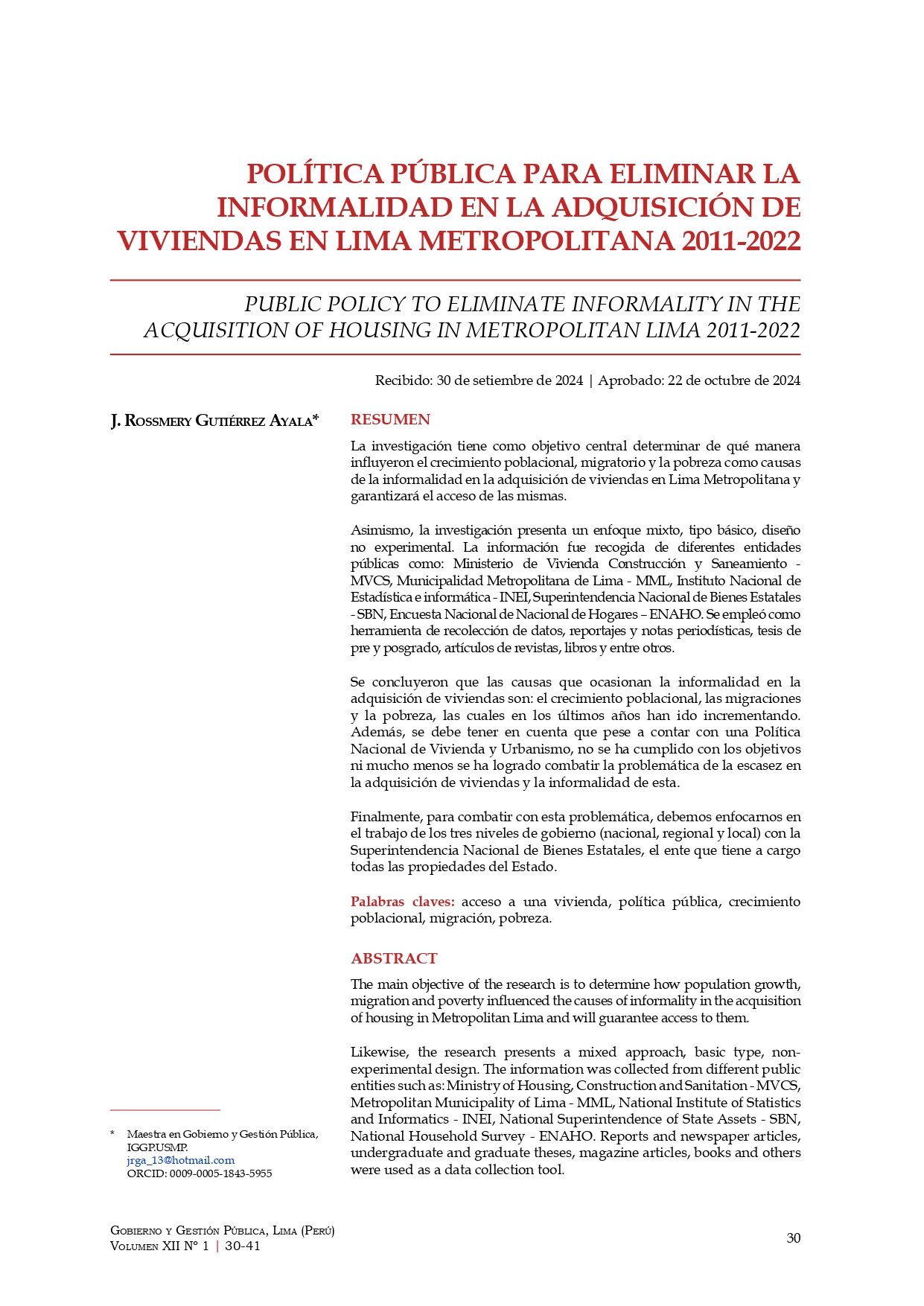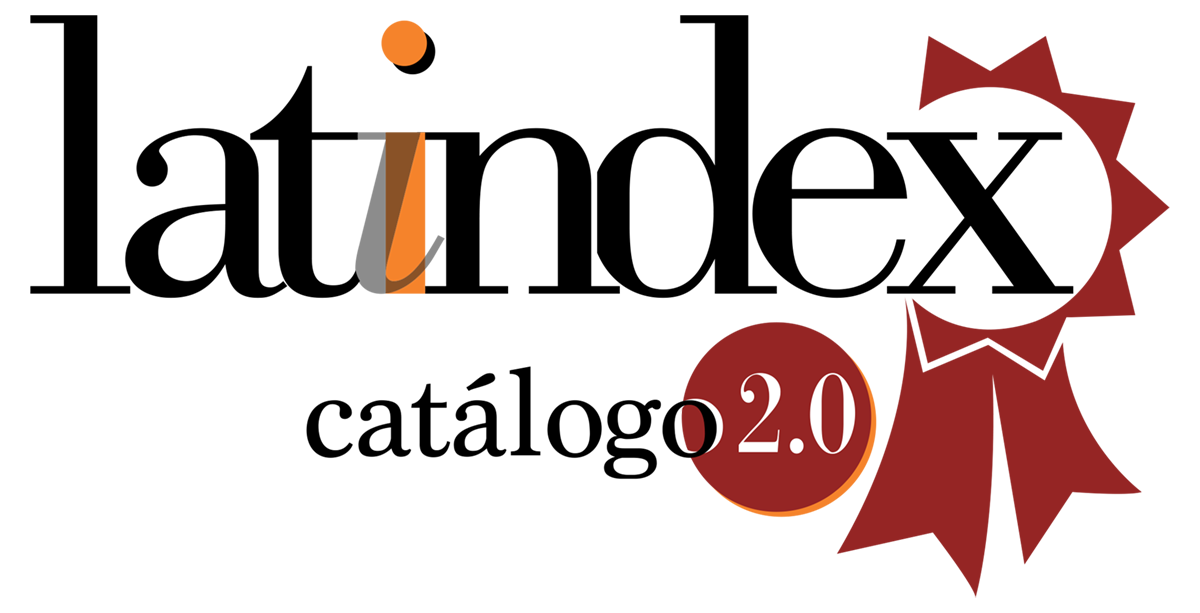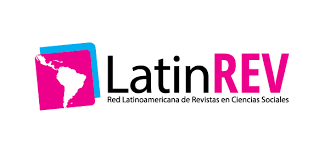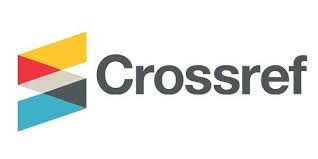Public Policy To Eliminate Informality In The Acquisition Of Housing In Metropolitan Lima 2011-2022
DOI:
https://doi.org/10.24265/iggp.2025.v12n1.04Keywords:
Access to housing, Public policy, Population growth, Migration, PovertyAbstract
The main objective of the research is to determine how population growth, migration and poverty influenced the causes of informality in the acquisition of housing in Metropolitan Lima and will guarantee access to them.
Likewise, the research presents a mixed approach, basic type, non-experimental design. The information was collected from different public entities such as: Ministry of Housing, Construction and Sanitation - MVCS, Metropolitan Municipality of Lima - MML, National Institute of Statistics and Informatics - INEI, National Superintendence of State Assets - SBN, National Household Survey - ENAHO. Reports and newspaper articles, undergraduate and graduate theses, magazine articles, books and others were used as a data collection tool.
It was concluded that the causes that cause informality in the acquisition of housing are: population growth, migration and poverty, which have been increasing in recent years. Furthermore, it should be noted that despite having a National Housing and Urban Development Policy, the objectives have not been met, much less has it been possible to combat the problem of the shortage of housing acquisitions and its informality.
Finally, to combat this problem, we must focus on the work of the three levels of government (national, regional and local) with the National Superintendence of State Assets, the entity in charge of all State properties.
Downloads
References
Acuerdo Nacional: POLÍTICAS DE ESTADO Y PLANES DE GOBIERNO 2016- 2021. Marzo 2016.
Antonio Stefano Caria. TÍTULOS SIN DESARROLLO: Los efectos de la titulación de tierras en los nuevos barrios de Lima (2008) DESCO.
Calderón Cockburn, Julio (2017). La insoportable levedad de la planificación urbana y lo legal informal en el Perú. DESCO: Centro de Estudios y Promoción del Desarrollo – 2017.
Calderón, J. (2019). El Estado y la informalidad urbana. Perú en el siglo XXI. Revista Pluriversidad de la Universidad Ricardo Palma.
CAPECO, Ministerio de Vivienda, Construcción y Saneamiento, UNIAPRAVI: Haciendo Ciudades Sostenibles. Noviembre 2011.
http://www3.vivienda.gob.pe/dgprvu/docs/Estudios/10%20Haciendo%20Ciudades%20Sostenibles.pdf
Cortés, L. (2010). “El problema de la vivienda en España: elementos para su comprensión, asumiendo que la vivienda es un lugar delimitado, construido como resultado de la actividad humana, donde las personas viven con cierta estabilidad”.
De Soto, H. (2009). El otro sendero: Una respuesta económica a la violencia. Grupo Editorial Norma S.A.C.
El Comercio. (2016). En el Perú faltan 1,8 millones de viviendas. https://elcomercio.pe/lima/peru-faltan-1-8-millones-viviendas-165624
Fuenteseca Degeneffe, M. (2004). La formación romana del concepto de propiedad. Ed. Dykinson.
Gálvez Ruiz, F., et al. (2016). En busca del lote propio: Hacia una verdadera política de vivienda en el Perú. Revista Ius et Veritas.
Kahatt, S. S. (2015). Utopías construidas: Las unidades vecinales de Lima. Fondo Editorial PUCP.
Ley N° 30156, Ley de Organización y Funciones del Ministerio de Vivienda, Construcción y Saneamiento.
Loayza, N. (2007). Causas y consecuencias de la informalidad en Perú. https://www.bcrp.gob.pe/docs/Publicaciones/Documentos-de Trabajo/2007/Working-Paper-18-2007.pdf
Meza, J. (2016). Tesis Máster: La vivienda social en el Perú. Evaluación de las políticas y programas sobre vivienda de interés social. Caso de estudio: Programa “Techo Propio”. Mayo 2016.
https://upcommons.upc.edu/bitstream/handle/2117/87782/MEZA_TESIS_MASTER.pdf?sequence=1&isAllowed=y
Ministerio de Vivienda, Construcción y Saneamiento (MVCS). (2005). Situación de los barrios urbano-marginales en el Perú 2004, Primera Aproximación. Lima: MVCS.
Ministerio de Vivienda, Construcción y Saneamiento (MVCS). (2013). Situación de los barrios urbano-marginales en el Perú 2012, Segunda Aproximación. Lima: MVCS.
Ministerio de Vivienda, Construcción y Saneamiento. (2021). Política Nacional de Vivienda y Urbanismo.
Morales Tejada, M. (2016). Estudio de caso: La Asociación Casa Granja Nueva Villa y la Asociación de Poseedores San Luis Gonzaga [Tesis de Maestría].
Norman Loayza, C. (2007). Causas y consecuencias de la informalidad en Perú. https://www.bcrp.gob.pe/docs/Publicaciones/Documentos-de-Trabajo/2007/Working-Paper-18-2007.pdf
ORTIZ, J. I., VILCHEZ, X. A., & VALENCIA, C. I. (2020). Derecho urbanístico, planificación territorial y otros retos trazados por la pandemia del COVID-19. Kawsaypacha Sociedad y Medio Ambiente.
RPP Noticias (Vía Web). (2016). Perú es el tercer país de Latinoamérica con mayor déficit de viviendas.
Reglamento de Organización y Funciones del Ministerio de Vivienda, Construcción y Saneamiento, aprobado por Decreto Supremo N° 010-2014-VIVIENDA y su modificatoria por Decreto Supremo N° 006-2015-VIVIENDA.
Reglamento de Organización y Funciones de la Superintendencia Nacional de Bienes Estatales.
Richard Pipes. (2002). Propiedad y libertad: Dos conceptos inseparables a lo largo de la historia. Editorial Turner y Fondo de Cultura Económica.
Universidad Privada del Norte. (2017). La Vivienda Informal en Lima. http://blogs.upn.edu.pe/arquitectura/2017/07/13/la-vivienda-informal-en-lima/
Vásquez Ríos, A. (2013). Los Derecho Reales I Tomo Los Bienes – La Posesión. Editorial San Marcos.
Ordenanza N° 2499-2022 – Ordenanza que aprueba el Plan de Desarrollo Metropolitano de Lima 2021-2040 Planmet 2040.

Downloads
Published
Issue
Section
License
Copyright (c) 2025 Jael Rossmery Gutiérrez Ayala

This work is licensed under a Creative Commons Attribution-NonCommercial-ShareAlike 4.0 International License.














